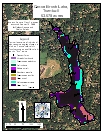Canoe Brook Lake, Trumbull - 2004
2004 Aquatic Plant Survey Map of Canoe Brook Lake
Canoe Brook Lake measures 63.7 acres and is located in Trumbull. The 189-member association regulates use of land around the lake which has 80 homes. Any alterations within 50 feet of the water must be approved by the association. A buffer of trees exists between homes and the shoreline, and homes are set back from the shore. Houses on the east side of the lake were connected to public sewers in 1988, and houses on the west side were scheduled to be connected in 2006. The association maintains a water-testing program and a website that provides information on ways to protect the environmental quality of the lake, which was created as a water storage reservoir in 1891 (Canoe Brook Lake Association). The lake’s use as a reservoir was discontinued in 1931, and the Bridgeport Hydraulic Co. sold the lake and the surrounding area for private development in 1947. The lake association now maintains four beaches and a boat launch (all boat motors are prohibited) for members.
Ten aquatic plant species were collected during an August 2004 survey of Canoe Brook Lake. The most abundant aquatic plant in the lake during an August 2004 survey was slender naiad (Najas flexilis), which was found throughout the lake growing luxuriantly in water 1 to 9 feet deep and never occurring at a depth of more than 20 feet. The invasive minor naiad (Najas minor) was found growing with slender naiad throughout the lake, although it was less abundant. Minor naiad was found in shallower water, not exceeding 8 feet.
In addition to the two naiad species, the western side of the lake supported many large patches of eelgrass (Vallisneria americana), a species that has been of concern to some lake residents. Several herbicide treatments have been applied in recent years to reduce abundance of eelgrass. The very active Canoe Brook Lake Association also has arranged for dredging in several areas to combat eelgrass.
In addition to the two naiads and eelgrass, dwarf spikerush (Eleocharis parvula) and small pondweed (Potamogeton pusillus) were found on the western side of the lake, mostly at the northern and southern ends. Large areas of the west side had rocky substrate where no plants occurred.
Slender naiad and minor naiad were the most abundant species on the eastern side of the lake, occurring without the interruptions found on the western side. Many patches of eelgrass also were observed, as well as several small patches of small pondweed. At the southern end of the lake, several large patches of eelgrass were found, and the naiad species occurred in deeper water. The lake reaches a maximum depth of 30 feet near a dam at its southern end.
A stream enters a cove at the northern end of the lake. The cove supported a large population of western waterweed (Elodea nuttallii), and a water starwort (Callitriche species) occurred with the western waterweed. Slender naiad also was abundant in the cove, and minor naiad was present but less abundant. Patches of small pondweed and eelgrass also were observed..
| Species recorded in our 2004 survey of Canoe Brook Lake. Scientific Names *Invasive Species |
||||
| American waterwort | Minor naiad* | Water starwort | ||
| Dwarf spikerush | Ribbon-Leaf pondweed | Western waterweed | ||
| Eelgrass | Slender naiad | |||
| Low watermilfoil | Small pondweed | |||


